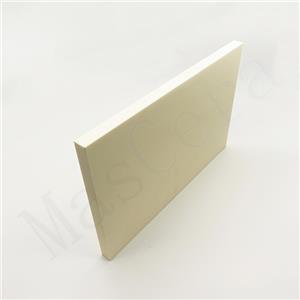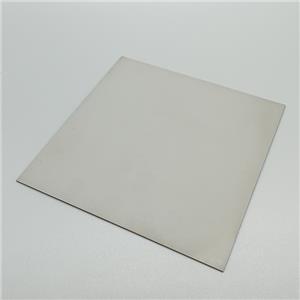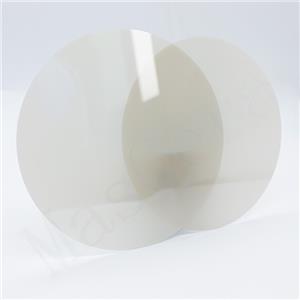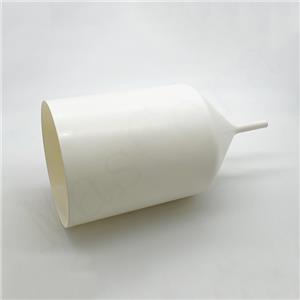Application of Advanced Ceramics in Textile Industry
The ceramic materials used for manufacturing textile components are required to possess high hardness, high strength, and excellent corrosion resistance. Commonly used ceramic materials for textile component fabrication can be categorized into four main types: alumina ceramics, titania ceramics, zirconia ceramics, and zirconia-toughened alumina ceramics.
Alumina ceramics exhibit high hardness, good chemical stability, high temperature resistance, and excellent wear resistance, making them suitable for processes such as spinning, drawing, spinning, stretching, weaving, and knitting.
Titania ceramics offer good wear resistance and conductivity, making them suitable for yarn racks, stretching machines, spinning, and winding processes.
Zirconia ceramics feature good wear resistance, chemical stability, high temperature resistance, and high toughness, making them suitable for spinning, stretching, and cutting line sections.
Zirconia-toughened alumina ceramics combine high hardness, good wear resistance, chemical stability, and some degree of toughness, making them suitable for thread guides, line cutters, spinning, and stretching machines.
Currently, textile ceramic components are broadly classified into three categories: friction discs, line cutters, and thread guides.
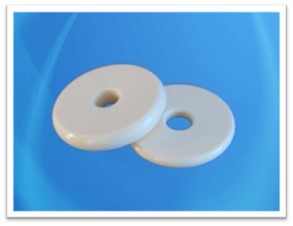
1、Friction discs can be divided into two types based on material: one is hard rigid bodies, such as all-ceramic discs, plasma-sprayed ceramic discs, and diamond sand discs; the other type is soft material discs, such as polyurethane friction discs. The advantage of ceramic friction discs lies in their wear resistance, which enables them to maintain their surface structure for a long time, ensuring stable yarn quality.
2、Line cutters are commonly found in automatic winding machines, such as air door scissors and tension scissors. Automatic winding machines are key equipment in the textile industry for improving yarn winding quality for export and earning foreign exchange. Ceramic scissors have a high hardness of 1300~3000HV, excellent high-temperature performance, good hardness, excellent anti-adhesive properties, and good chemical stability.

3、Thread guides are indispensable in weaving equipment. The trend toward high-speed production and diverse fibers requires ceramic thread guides with higher precision, higher surface finish, and lower energy consumption. In recent years, a variety of ceramic thread guides have been developed, among which titania ceramics are advantageous as high-speed spinning thread guides because they prevent the accumulation of "white powder" caused by friction static electricity between the thread and the ceramic, thereby preventing a decrease in yarn quality or breakage. This utilizes the semiconductor properties of titania materials, which also have relatively high hardness and good wear resistance.
The application scope of engineering ceramics in textile engineering is wide-ranging. In addition to the main components mentioned above, it also includes ceramic spinning nozzles, which stabilize yarn spinning; high-precision ceramic rotating components used in stretching, deformation, winding, and stretching yarn processes, helping to reduce failures during continuous production and simplify or reduce operational procedures; ceramic drive pinions for looms, whose lower density reduces the inertia of intense motion; and zirconia ceramic sliders, essential components in weaving machines, which have very low static and dynamic friction and excellent dry operation.
Types and characteristics of ceramic textile products:
1、Ceramic fiber textiles:
Ceramic fibers are inorganic fibers with dual functions of thermal insulation and fire resistance, mainly composed of alumina and silica. They are generally classified into two major categories based on alumina content: aluminum silicate fibers and alumina fibers. Aluminum silicate fibers are dispersed fibers produced by melting raw materials and using spinning or blowing methods, while alumina fibers are continuous filament fibers produced by spinning molten raw materials.
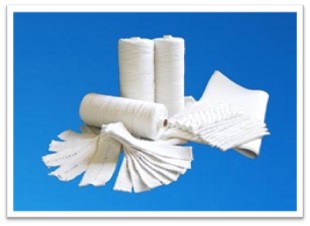 Ceramic fiber products possess characteristics of both ceramic materials and textile products, such as high temperature resistance, good chemical stability, excellent thermal insulation performance, good sound absorption performance, and relatively high strength. Therefore, they are widely used in industries such as petrochemicals, electricity, and metallurgy for insulation and refractory engineering.
Ceramic fiber products possess characteristics of both ceramic materials and textile products, such as high temperature resistance, good chemical stability, excellent thermal insulation performance, good sound absorption performance, and relatively high strength. Therefore, they are widely used in industries such as petrochemicals, electricity, and metallurgy for insulation and refractory engineering.
Compared to organic fibers, ceramic fibers have poor spinnability and disadvantages such as brittle fiber quality, easy breakage under mechanical action during processing, extremely smooth fiber surfaces resulting in poor interlocking between fibers, and difficulties in forming webs or strands. Additionally, ceramic fibers exhibit poor moisture absorption and conductivity, leading to severe static electricity during processing. Therefore, the processing and manufacturing of such products require corresponding technological improvements.
2、Functional ceramic textiles:
Various ultrafine ceramic powders possess unique properties and large surface areas. For example, zinc oxide powder has good absorption and reflection of ultraviolet light, effectively preventing the occurrence of diseases such as skin cancer; monoclinic zirconia crystals can absorb external energy and emit far-infrared rays similar to the biological wave spectrum of the human body. The production technologies for developing ceramic functional textiles mainly fall into two categories: adding ceramic powders during the processing of chemical fibers, i.e., adding ceramic powders during melt spinning to impart certain functional effects to the produced synthetic long fibers or short fibers; using surface coating methods, i.e., uniformly dispersing ceramic powders in binders and applying them to fabrics to form functional films.
Commonly used ceramic materials for UV shielding are high refractive index metal oxides, such as zinc oxide and titanium dioxide. Deodorizing ceramic textiles mainly use materials such as activated carbon, zinc oxide, silica, alumina, magnesium oxide, etc. Textiles containing oxide ceramic powders with particle sizes below submicron have certain antibacterial effects.
Compared to other functional textiles, the advantage of ceramic functional textiles lies in their ability to achieve unique functions, as exemplified by the aforementioned materials. However, challenges faced by industry professionals include enhancing the cost-effectiveness of ceramic applications in textiles, accelerating the industrialization process of ceramic textile products, exploring market potential, improving product quality, reducing production costs, and rapidly translating research results into productivity.
XIAMEN MASCERA TECHNOLOGY CO., LTD. is a reputable and reliable supplier specializing in manufacturing and sales of technical ceramic parts. We provide custom production and high precision machining for a wide series of high performance ceramic materials including alumina ceramic, zirconia ceramic, silicon nitride, silicon carbide, boron nitride, aluminum nitride and machinable glass ceramic. Currently, our ceramic parts can be found in many industries like mechanical, chemical, medical, semiconductor, vehicle, electronic, metallurgy etc. Our mission is to provide the best quality ceramic parts for global users and it is a big pleasure to see our ceramic parts work efficiently in customers' specific applications. We can cooperate on both prototype and mass production, welcome to contact us if you have demands.

